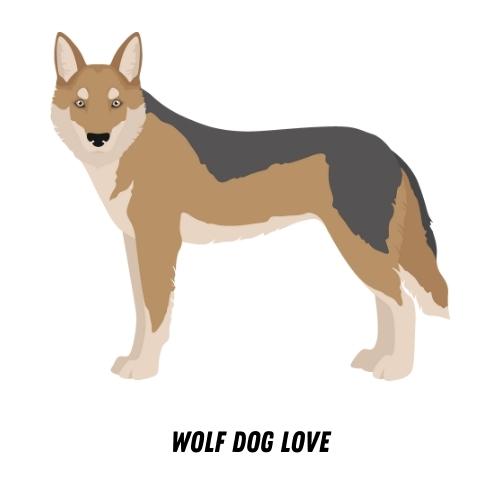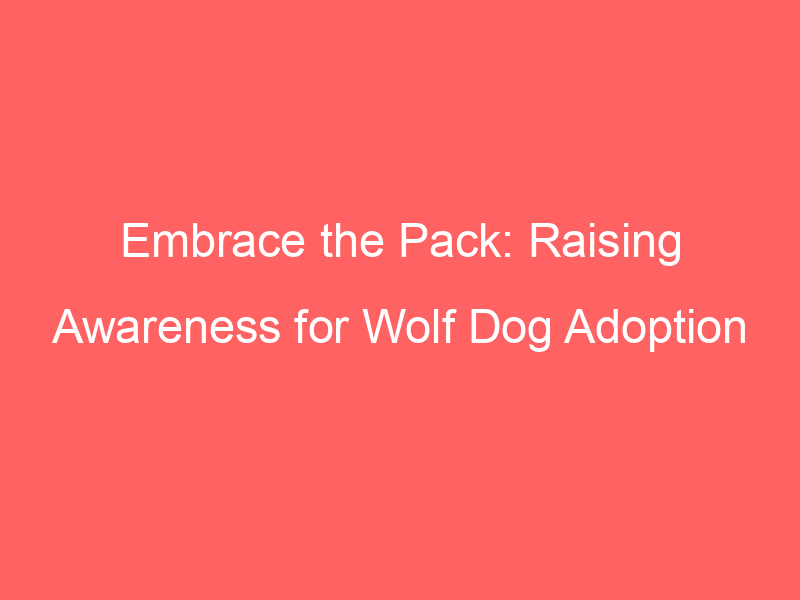Introduction: The Challenge of Multi-Pet Households
Having a pet in the house can be a source of joy and companionship. However, managing a multi-pet household can be quite a challenge. This is especially true when one of the pets is a wolf dog. In this blog post, we will delve into the intricacies of managing multi-pet households and the unique challenges posed by wolf dogs.
- Overview of the Complexity of Multi-Pet Households
- Specific Challenges Posed by Wolf Dogs
Managing a multi-pet household is no easy task. It requires a lot of patience, understanding, and knowledge about the behavior of different pets. Each pet has its own unique needs and personality, and it’s important to cater to these while maintaining harmony in the household. For instance, some pets may require more attention or a specific diet, while others may need more exercise or playtime. Balancing these needs can be a complex task.
Wolf dogs, a hybrid of domestic dogs and wolves, pose a unique set of challenges. They are known for their intelligence and independence, but these traits can also make them more difficult to manage. Wolf dogs have a strong prey drive, which can cause issues in a multi-pet household, especially if there are smaller pets. They also have a higher energy level compared to most domestic dogs, requiring more exercise and mental stimulation. Furthermore, wolf dogs can be wary of strangers and may require careful socialization.
In the following sections, we will delve deeper into understanding wolf dog behavior, training wolf dogs for multi-pet households, harmonizing pets at home, and practical tips for multi-pet home management. So, whether you’re a seasoned pet owner or considering adding a wolf dog to your family, this guide is for you.
Understanding Wolf Dog Behavior
Wolf dogs are unique pets with behaviors that can be quite different from other dogs. Understanding these behaviors is key to having a harmonious multi-pet household. Let’s delve into the general characteristics of wolf dogs and dispel some common misconceptions.
- General characteristics of wolf dogs
- Common misconceptions about wolf dogs
Wolf dogs, as the name suggests, are a mix between wolves and domestic dogs. This gives them a unique set of characteristics. They are typically larger than most dogs, with a strong, muscular build. They have a keen sense of hearing and smell, much like their wolf ancestors.
Wolf dogs are highly intelligent and can be trained, but they also have a strong instinctual drive. This can make them more challenging to handle than typical domestic dogs. They are often independent and may require more space and exercise than other dogs.
There are many misconceptions about wolf dogs. One common myth is that they are dangerous or aggressive. While wolf dogs are indeed powerful and can be assertive, they are not inherently aggressive. Much like any other dog, their behavior largely depends on their upbringing and socialization.
Another misconception is that wolf dogs are simply wild wolves. In reality, they are a hybrid of a wolf and a domestic dog, and their behavior can vary widely depending on the specific mix and the individual dog’s experiences.
In conclusion, understanding the behavior of wolf dogs is crucial for anyone considering adding one to their multi-pet household. They are unique, intelligent, and require a specific approach to training and socialization. By dispelling common misconceptions, we can better appreciate these remarkable animals and provide them with the care they need.
Wolf Dog Socialization
Wolf dogs are unique pets that require special attention, particularly when it comes to socialization. This process is crucial in shaping their behavior and ensuring they can live harmoniously with other pets and people. Let’s delve into the importance of early socialization and effective techniques for socializing wolf dogs.
- Importance of Early Socialization
Early socialization is a critical aspect of raising a well-adjusted wolf dog. It’s during their early months that wolf dogs learn and understand their environment, making it the perfect time to introduce them to various experiences and stimuli. This early exposure helps them grow into confident and well-behaved adults.
Without proper socialization, wolf dogs may develop fear and anxiety, leading to problematic behaviors such as excessive barking, chewing, and even aggression. A study by the American Veterinary Society of Animal Behavior found that puppies who were not adequately socialized were more likely to develop negative behaviors and were often more fearful of unfamiliar people, animals, and environments.
- Effective Socialization Techniques for Wolf Dogs
Now that we understand the importance of early socialization, let’s explore some effective techniques for socializing wolf dogs.
| Technique | Description |
|---|---|
| Exposure to Different Environments | Take your wolf dog to various places such as parks, pet stores, and walks around the neighborhood. This will help them get used to different sights, sounds, and smells. |
| Interaction with Other Animals | Allow your wolf dog to interact with other dogs and pets under controlled conditions. This will help them learn how to behave around other animals. |
| Positive Reinforcement | Use treats, praises, and toys to reward your wolf dog when they behave well during socialization exercises. This will encourage them to repeat the good behavior. |
Remember, patience is key when socializing your wolf dog. It’s a gradual process that requires consistent effort. But with time and patience, your wolf dog will learn to be a well-behaved and sociable member of your family.
Training Wolf Dogs for Multi-Pet Households
Training wolf dogs for a multi-pet household can be a challenging task. However, with the right approach, it is certainly achievable. The two key aspects to focus on are establishing boundaries and rules, and using training methods suitable for wolf dogs.
- Establishing Boundaries and Rules
- Training Methods Suitable for Wolf Dogs
Establishing boundaries and rules is the first step in training wolf dogs for a multi-pet household. This helps to create a sense of order and hierarchy, which is crucial in a multi-pet environment. Wolf dogs, like their wild counterparts, are pack animals and understand the concept of a social hierarchy. By establishing yourself as the pack leader, you can effectively manage and control your wolf dog’s behavior.
Boundaries can be physical, like designating certain areas of the house as off-limits, or behavioral, like setting rules for meal times and play times. Consistency is key when establishing boundaries and rules. Any deviation can confuse your wolf dog and lead to behavioral issues.
Wolf dogs are intelligent and quick learners, but they also have a strong will and can be stubborn. Therefore, traditional dog training methods may not always work. Instead, use training methods that are suitable for wolf dogs.
Positive reinforcement is one such method. This involves rewarding your wolf dog for good behavior, which encourages them to repeat that behavior. Rewards can be treats, praise, or play time. Avoid punishment as it can lead to fear and aggression.
Another effective method is socialization. Expose your wolf dog to different environments, people, and animals. This helps them to adapt to various situations and reduces their tendency to be aggressive or fearful.
Remember, patience and consistency are key when training wolf dogs. It may take time, but with the right approach, you can successfully train your wolf dog for a multi-pet household.
Case Study: Successful Wolf Dog Training in a Multi-Pet Household
- Background of the case
In our case study, we focus on a family with a diverse range of pets – two cats, a parrot, and a newly adopted wolf dog. The family faced challenges in integrating the wolf dog into their multi-pet household. The wolf dog showed signs of dominance and territorial behavior, causing tension among the pets.
- Training methods used
The family sought the help of a professional wolf dog trainer who used a combination of methods to train the wolf dog. The trainer focused on establishing boundaries and rules, using positive reinforcement and gradual exposure to the other pets. The wolf dog was trained to understand basic commands such as ‘sit’, ‘stay’, and ‘leave it’. The trainer also used desensitization techniques to reduce the wolf dog’s aggressive reactions towards the other pets.
Training Method Description Establishing boundaries and rules Creating a structured environment where the wolf dog understands its place in the pet hierarchy. Positive reinforcement Using rewards to encourage good behavior and discourage undesirable actions. Gradual exposure Slowly introducing the wolf dog to the other pets to reduce fear and aggression. Desensitization techniques Exposing the wolf dog to triggers in a controlled manner to reduce its aggressive reactions. - Key takeaways from the case study
The case study demonstrated that with proper training methods, it is possible to integrate a wolf dog into a multi-pet household. It highlighted the importance of professional guidance, patience, and consistency in training. The family reported a significant improvement in the wolf dog’s behavior, with reduced aggression and better interaction with the other pets. This case study underscores the fact that understanding wolf dog behavior and using appropriate training methods can lead to successful pet harmony in a multi-pet household.
Harmonizing Pets at Home: Wolf Dog and Other Pets
Living with multiple pets can be a joyful experience, but it can also present challenges, especially when one of those pets is a wolf dog. Wolf dogs are unique creatures that require special care and understanding. In this section, we will discuss how to introduce a wolf dog to other pets and manage potential conflicts.
- Introducing a Wolf Dog to Other Pets
- Managing Potential Conflicts
Introducing a wolf dog to other pets is a delicate process that requires patience and understanding. Start by allowing the pets to sniff each other’s items, like toys or bedding, to get used to their scents. Then, introduce them in a neutral space where neither pet feels territorial. Always supervise these interactions and reward positive behavior with treats or praise.
Despite your best efforts, conflicts may arise when introducing a wolf dog to other pets. It’s essential to understand the signs of stress or aggression in each pet and intervene before a conflict escalates. If a conflict does occur, separate the pets immediately and give them time to calm down. Never punish a pet for conflict, as this can increase stress and make the situation worse.
Remember, every pet is unique and may react differently to new situations. It’s important to be patient and understanding during this process. With time and effort, your wolf dog can live harmoniously with other pets in your home.
Wolf Dog Integration: Balancing Multi-Pet Homes
Integrating a wolf dog into a multi-pet home requires careful planning and execution. The key to success lies in creating a balanced environment and ensuring each pet’s needs are met. Let’s delve into these aspects in detail.
- Creating a Balanced Environment
- Ensuring Each Pet’s Needs Are Met
Creating a balanced environment is crucial for a harmonious multi-pet home. This involves setting up spaces that cater to the unique needs of each pet. For instance, wolf dogs, being a high-energy breed, need ample space for physical activity. On the other hand, smaller pets might need safe, quiet corners to retreat to.
It’s also important to maintain a consistent routine. Regular feeding times, exercise schedules, and playtimes can help pets understand what to expect and reduce potential conflicts. Remember, balance doesn’t mean equal treatment. It means understanding and catering to each pet’s individual needs.
Every pet in your home has unique needs, and it’s your responsibility to ensure they are met. This involves providing proper nutrition, regular exercise, and mental stimulation. For wolf dogs, this might mean a high-protein diet, lots of physical activity, and puzzle toys for mental engagement.
Regular vet check-ups are also essential to monitor each pet’s health. It’s also important to spend quality time with each pet, giving them the attention and affection they need. This not only helps in building a strong bond with your pets but also in understanding their behavior better, allowing you to spot any potential issues early on.
| Pet Needs | Wolf Dog | Other Pets |
|---|---|---|
| Nutrition | High-protein diet | Varies based on breed and size |
| Exercise | High physical activity | Varies based on breed and size |
| Mental Stimulation | Puzzle toys, training sessions | Varies based on breed and size |
| Vet Check-ups | Regular | Regular |
In conclusion, integrating a wolf dog into a multi-pet home can be a rewarding experience if done right. By creating a balanced environment and ensuring each pet’s needs are met, you can foster a harmonious home where every pet thrives.
Multi-Pet Home Management: Practical Tips
Managing a home with multiple pets, especially when a wolf dog is part of the mix, can be a challenging task. However, with the right strategies, it is possible to create a harmonious environment for all your pets. Here are some practical tips to help you manage your multi-pet home effectively.
- Establishing routines
- Providing individual attention to each pet
Just like humans, pets thrive on routines. Establishing a consistent daily schedule for feeding, exercise, and rest can significantly help in managing your multi-pet home. For instance, feeding your pets at the same time every day can reduce competition for food and prevent conflicts. Similarly, scheduling regular exercise sessions can help keep your pets healthy and reduce behavioral issues.
Each pet in your home has unique needs and personalities. Therefore, it’s essential to spend quality time with each pet individually. This not only strengthens your bond with them but also allows you to understand their behaviors better. For example, wolf dogs are known to be highly intelligent and require mental stimulation. Spending time playing intelligence-boosting games with your wolf dog can help meet this need.
In conclusion, managing a multi-pet home requires a balance of routine and individual attention. By establishing consistent routines and spending quality time with each pet, you can create a peaceful and harmonious environment for all your pets.
Conclusion: Wolf Dog in Family Homes
As we wrap up our discussion on wolf dogs in family homes, it’s essential to reiterate some crucial points. The journey to successfully integrating a wolf dog into a multi-pet household is one that requires patience, understanding, and proper training.
- Reiterating the Importance of Understanding and Training
- Final Thoughts on Integrating Wolf Dogs into Multi-Pet Households
Understanding your wolf dog’s behavior is the first step towards a harmonious home. Remember, wolf dogs are unique creatures with instincts and behaviors that differ from regular dogs. They require special attention and training to coexist peacefully with other pets.
Training your wolf dog is not just about teaching it to obey commands. It’s about helping it understand its place in your home and how to interact with other pets. Remember, consistency is key in training. Regular, positive reinforcement can go a long way in shaping your wolf dog’s behavior.
Integrating a wolf dog into a multi-pet household is not an impossible task. However, it requires a commitment to understanding and training. It’s important to remember that every pet in your home has its own unique personality and needs. Therefore, it’s crucial to ensure each pet feels safe, loved, and respected.
Wolf dogs can make wonderful additions to your family if given the right environment and care. They are intelligent, loyal, and can form deep bonds with their human families. However, they are not the right fit for every household. Before deciding to bring a wolf dog into your home, it’s important to consider if you can meet its unique needs and provide a harmonious environment for all your pets.
In conclusion, the key to a successful multi-pet household with a wolf dog lies in understanding, training, and patience. With these, you can create a home where all your pets can thrive together.








